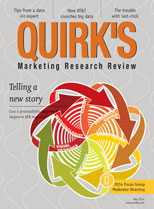A Systematic, Stepwise Procedure for Improving the Actionability of Marketing Research
In his new book, The AIM Process, Paul Conner outlines how marketing researchers and marketing research users can work together in designing and conducting marketing research that provides solid direction in making decisions from its results. This article, adapted and edited from a chapter in the book, addresses the challenge created by a purpose-process disconnect and why MR must be actionable to be useful.
A fundamental problem with marketing research lies in a disconnect between its primary purpose and the procedure by which it's traditionally conceived, designed and conducted. To understand this fundamental marketing research problem (i.e., its purpose-process disconnect) we need to clarify marketing research's fundamental purpose. The AIM Process assumes the following about the fundamental purpose of marketing research.
Marketing research exists to support certain decisions and actions that intend to achieve certain outcomes for certain products and services among certain types of people.
Key to this statement of purpose is that marketing research is an applied discipline. It exists to be used. It exists to support decisions and actions. Further distinguishing its purpose, marketing research is fundamentally not an academic, information-only discipline. Yes, providing information is a necessary component of marketing research but information itself is not its sufficient or defining characteristic.
To further clarify this purpose, I claim that "decisions and actions" are collectively the key components in marketing research's fundamental purpose. You'll see later that I collectively call decisions and actions "Applications" (and capitalize that term because of its importance to The AIM Process). If marketing research doesn't support decisions and actions (i.e., Applications), it isn't doing its job. It's flawed and needs to be improved (or in some cases not even conducted).
Accepting this applied purpose of marketing research, its fundamental problem is that the way it's typically designed and conducted does not effectively deliver its intended decision support. Too often at the end of a marketing research study, represented by the final report, marketing research users say things like...
- "This is great information but what do I do with it?"
- Referring to a key statistic in the results, "Is 24 percent a good number?"
- "I understand that the study was designed to help me choose a target for my product but what is it saying about what I should charge for it? Can you please look at the results again and advise me regarding this?"
- "I need to understand better what this is saying about my non-customers. Why didn't we survey them?"
- "This is telling me that 35 percent of people aware of my brand have negative feelings about it. Where are those negative feelings coming from and how do I change them?"
Each of these comments, which have been paraphrased from real world examples, come from people who did not get what they wanted or needed from a marketing research study. Why? And what could they have done to prevent it?
The answers to these questions can have many foci but all point toward the same thing: a flaw in the procedure. More specifically, the answers likely point to a flaw that diverted it from the fundamental purpose of the study - supporting a certain Application or Applications.
The following summarize many of these procedural flaws:
- Marketing research requests are often made very quickly, without being thought out very well.
- Similarly, marketing research is often needed very quickly, without time to think things out very well.
- Marketing research requesters - ultimately marketing research users - often ask just for techniques.
- Marketing research requesters - ultimately marketing research users - often ask just for information.
- Marketing research requests typically do not include the thoughts of all those who will be involved in the ultimate Applications.
- Marketing research requests seldom clarify the Applications that are to be made on the basis of the research.
Of these flaws, the last is most critical and most represents the fundamental problem with marketing research that The AIM Process addresses: not basing the design and execution of a marketing research study on its primary purpose, which is supporting marketing decisions and action.
By taking an Applications > Information > Methods sequential approach - that is, if we take better AIM - marketing decisions and actions will by default be better supported and the money spent on the AIM-guided marketing research study will not be wasted.
